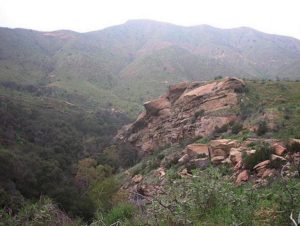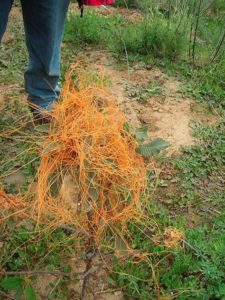“Water collected in the sediment trap in the reactor area drainage was also tested for radioactivity. The test was negative for strontium-90, while the gross alpha test showed 16.2 ± 6.9 pCi/L. This sample sat in the sediment trap, in contact with soil, for up to a year. This would account for a positive finding, with the most likely source of radioactivity being natural radioactive minerals [ER NOTE: 1,372-PAGE TEST AND STUDY CAN’T DETERMINE ISOTOPE?] dissolved out of the soil (e.g., thorium, radium). Reactor products can be largely ruled out since very few of these emit alpha radiation, and since Sr- 90 was not detected. On the other hand, thorium, radium, and nearly all naturally radioactive minerals emit alpha radiation. There was insufficient volume to test for gamma-emitting nuclides. [ER NOTE: WHY WAS THAT? COULDN’T MORE HAVE BEEN SAMPLED?]
“CONCLUSIONS AND RECOMMENDATIONS
“Results are unremarkable. Analytes are at or near background levels [ER NOTE: – FALSE – DIOXIN AT 31.8 BTV, for one], or not present at all. Results continue to show that the BBC property is free of contamination. [ER NOTE: WHOLE REPORT CREDIBILITY IN QUESTION SINCE CEHN HAD ACCESS TO SAME GOV REPORTS ER DID] Drainage ravine sediments that could potentially carry contaminants toward BBC are free of contamination [ER NOTE: TRITIUM IN BB-16A and other springs DISPROVES THIS]. Groundwater near the property line contains trace levels of tritium, but these are diminishing. I wouldn’t recommend further testing for at least another year.
“Copies of the lab reports are attached. Please contact me if you have any questions.”
[ER NOTE: AJU provided only this lengthy and confusing report, with no table of contents, for 2017. Not one other year comes with a report like this as will be seen following.]
3A. PAGE 4 SHOWS 6 LOCATIONS FOR SOIL TESTING; PAGE 5 SHOWS 6 LOCATIONS FOR WATER TESTING AND 20% TEST POSITIVE FOR SSFL TRITIUM.
D. 5/1,372: “Table 2. Water Tested”
Location: Spring OS-10
Analyzed for: TCE, Tritium, Stronium-90, Gross alpha rad.
Comments: Near Old Well campsite”
[ER NOTE: Cehn has this conflated perhaps. OS-10, the bathtub well reported on in Brandeis-Bardin’s Toxic Denial, is not “Near Old Well campsite,” meaning OWC-2 was NEVER retested for tritium found in 2006. Regardless, his OS-10 sample was handled poorly as 4A shows below.]
DTSC report on OS-10: http://www.dtsc-ssfl.com/files/lib_offsite_investig/bbi/Reports/67220_Feb_2014_OS-10_lab_results.pdf
P. 26/43 of above OS-10 report says water collected 2/18/14
[ER NOTE: Brandeis-Bardin’s Toxic Denial map, https://www.enviroreporter.com/wp-content/uploads/2017/01/Brandeis-Bardin-OS-10-well-with-high-radiation.jpg, shows OS-10 to be 0.78 miles apart. [Measuring on full screen, distance = 9.3 cm with 4.5 cm = 2,000′ therefore 9.3/4.5 x 2000 = 4133’/5280 = 0.78 miles.
Further confusing locations, the 1,372-page report has a map on page 6 showing “Spring OS10” about 2/3rds of the way from the real OS-10 and what appears to be the Old Well campsite. EnviroReporter.com could not find in this massive report, with no table of contents or index, just exactly what were the measurements of the waters cited as “Spring OS10.” Whatever they were, apparently they didn’t arrive at the lab without complications.]

E. P. 10/1,372: “The temperature of the samples upon receipt was 15 degrees C. After a discussion with the client, the decision was made to proceed with analysis. Sample OS-10 (VOA) collected 1/16/2017—not preserved—received 1/24/2017 with hold time exceeded. Decision made by client to proceed with all analysis.”
[ER NOTE: That temperature is over double the 6 degree C limit the lab references following. Add to that a sample wasn’t preserved and its hold time exceeded. Regardless, Cehn gave the go-ahead even knowing NBC4‘s I-Team had BBI environmental tests in their sites and careful handling of samples might be important.]
F. P. 10/1,372: “This data package contains sample and QC results for eight (8) soil samples requested for the above referenced project on 1/23/2017”
[ER NOTE: JUST 8 SOIL SAMPLES for all of Brandeis-Bardin’s 2,878 acres or one every 360 acres. Contrast that with the hundreds of samples per acre done when accessing Area IV’s radiation and chemical contamination half a decade ago.]
G. P. 32/1,372: “I received a call on 1/27/17 from Eurofins (Stacy Hess) saying that they had received the samples on 1/26/17 but that they were above the 6 degrees C maximum temperature and wanted to know if we were going to re-submit the samples, wrote the lab’s Rodney Varnell Feb. 6, 2017 to Cehn. “Taking the previous discussion with you about ARS receiving the samples above the 6 degrees C maximum temperature into consideration, I authorized her to proceed with the analysis.”
Cehn replied later that morning “A-OK.”
[ER NOTE: Even this few number of soil samples seems to have been mishandled with little concern to correct mistakes and re-submit for analysis.]
H. P. 1,091/1,372: “This data package contains sample and QC results for four (4) aqueous samples (3 actual samples and 1 trip blank) requested for the above referenced project on 1/23/2017.”
…
“Sample OS-10 was collected on 1/16/2017 and received on 1/24/2017 exceeding holding time for a non-preserved sample. Samples OS-3 and BB-17 expired the day of receipt but were all analyzed after consulting with the client who authorized analysis. The samples were also above the 6 degree C limit and all were authorized for analysis by the client. Some of the requested analytical results did not meet the required detection limits due to insufficient sample volume and possible matrix interference.”
[ER NOTE: JUST THREE WATER SAMPLES for 2,878 acres or one for every 959 acres… And, again there appears to have been problems in the handling of the aqueous samples meaning that both water and soil samples were not handled according to lab spec. According to AJU’s report here, all 1,372 pages for 11 soil and water samples, Cehn delivered the samples too late, non-preserved and too hot yet Cehn A-OKAY’d them all the same.]
I. P. 1,093/1,372: “Samples received not preserved except for Trip Blank and OS-3 for VOA.”
J. P. 1,096/1,372: OS-3, 0S-10 & BB-17:
K. P. 1,100/1,372: “OS-10 received in unpreserved 40 ml vial”

1. BBC (BBI) 2015 Winter Testing Results, December 2015
http://aboutus.aju.edu/uploadedFiles/Updates1/BBC%20(BCI)%202015%20Winter%20Testing%20Results,%20December%202015.pdf :
7 pp
[ER NOTE: Old well campsite NOT tested for tritium in the water after shocking 2006 discovery.]
P. 1/7: “I should note that since about 2012, Boeing has stopped discharging rainwater runoff from Area IV into the Northern Buffer Zone.” [ER NOTE: FALSE]
P. 2/7: “Three samples near the property line (Boeing Runoffs 2b and SRE) showed heavier organics at 140 to 190 parts per million (ppm). All other results were between less than 1 and 67 ppm.
“Although a small residue was detected this month, levels are minor and safe, and don’t extend far into BBC property. Hydrocarbons due to petroleum products are quite common in developed areas.”
P. 2/7: “Tritium is the most mobile of the radioactive elements found at Boeing. It has been found in groundwater and vegetation near the property line. Testing is done to gauge its movement in groundwater, which is toward BBC. Water was collected from five flowing springs. It was also collected from plant foliage, close to the property line. This method collects water from plant transpiration, and has been an efficient way to collect groundwater, without the need for a drilled well. Locations are listed in Table 2.
“Results show very low levels of tritium (up to 26 pCi/ L) in the springs at the southwest corner of the property. No tritium was detected more distant from the property line, at OS-9. In 2007, I measured higher levels (up to 140 pCi/L) in the southwest area but slightly lower levels last year (up to 10 pCi/L). In 1995, levels were as high as 520 picocuries per liter of water (pCi/L) in Boeing’s Northern Buffer Zone. The drop over time is partly due to radioactive decay-half of the tritium transmutes to helium every 12 years. It is also due to dispersion and dilution. Figure 3 displays the results and includes a rainwater sample tested in 2006, containing natural tritium at 29 pCi/L. Natural tritium is created by cosmic rays in the upper atmosphere.”
P. 3/7: “CONCLUSIONS AND RECOMMENDATIONS
The observed levels of tritium in groundwater show a decline based on previous testing. They also compare with levels naturally found in the environment. Tritium was released by Rocketdyne decades ago and levels are expected to continue decreasing.”
P. 5/7: MAP
P. 7/7: See “Figure 3. Tritium Results”
[ER NOTE: Rain used to make it look normal that tritium is squirting out of all sources but one 5/6 springs have tritium]












Recent Comments